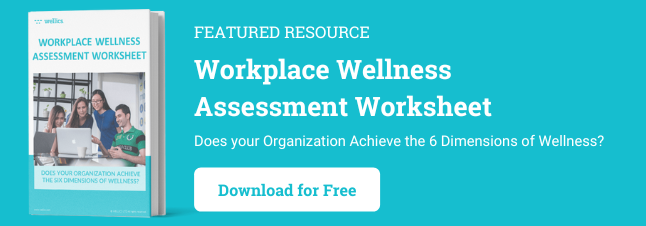Emotional health in the workplace is essential to a productive and thriving organization. Employees with high levels of emotional well-being may be more productive and engaged and take fewer sick days.
How can organizations boost the emotional well-being of their employees? Employee wellness programs can help organizations make emotional wellness a priority by providing a framework to help employees take charge of their emotional well-being.
This guide to emotional wellness activities for your employees covers some of the top emotional wellness ideas for reducing stress and boosting positivity in the work environment.
Why Emotional Wellness Is Important
Emotional wellness is one of several wellness dimensions that make up a person’s ability to thrive. Just as physical wellness prevents disease and illness, emotional wellness ensures we feel good about our lives. Emotional wellness is the degree to which a person is aware of their emotions and can understand and accept them, especially during life challenges.
How does emotional wellness affect health in the workplace? According to the American Psychological Association, poor emotional well-being and high stress levels can lead to health problems, like high blood pressure, weakened immune systems, and poor sleep. As a result, employees with poor levels of emotional well-being may experience more sick days and higher rates of absenteeism and presenteeism.
Emotional wellness at work can help employees:
- Find deeper job satisfaction
- Engage cooperatively with coworkers
- Feel motivated to pursue career goals
- Stay focused and productive
- Better navigate a dynamic work environment
While we all experience stress, fear, pain, or other negative emotions, how well we’re able to bounce back from these events determines our emotional well-being. Emotional wellness affects our everyday lives, including our abilities to perform productively at work or school, be present with our friends and family, and take care of our overall health and well-being.
10 Examples of Emotional Wellness Activities at Work
Boost employee emotional wellness by implementing a range of emotional health activities at work. From emotional wellness group activities to individual practices for managing stress, there are many ways for organizations to create an emotionally healthy workplace.
Below are some of the top ideas for how to achieve emotional wellness:
1. Company values seminar: Having meaning and direction in life plays an important role in emotional wellness. To increase your employees’ sense of purpose at work, host regular meetings to discuss your company’s values and mission.
2. Employee vision boards: When employees set their sights on the future, they tend to experience better emotional well-being at work. Organize a vision board group activity where employees create collages with images that inspire them in their personal and professional lives.
3. Nominate a colleague program: Recognition goes a long way in boosting positive self-esteem. Set up a nomination program where co-workers can publicly recognize each other for their contributions, hard work, or support.
4. Weekly jokes or funny videos: They say that laughter is the best medicine, so it’s important for our emotional health to add a bit of humor to our days. Send out a joke or a funny video in a weekly staff newsletter to help keep spirits high.
5. Walking meetings: Give employees a change of scenery by taking your meetings outdoors. Walking meetings or meetings in outdoor spaces can help infuse more emotional wellness into the workday.
6. 30-day unplug challenge: Heavy social media and technology use can have negative emotional effects. Launch a 30-day office challenge to encourage employees to disconnect from tech after work and on the weekends.
7. ACT counseling and training: There are many types of therapy that can help with negative emotions, including ACT — Acceptance and Commitment Therapy. Provide ACT training to help employees learn to cope with negative feelings by thinking about challenging situations in a new light.
8. Quarterly collaborative projects: Enhance both social and emotional well-being in the workplace by implementing quarterly collaborative projects. Have employees from across different departments get together to work on a new initiative or project that benefits the organization.
9. Office social events: Spending time with co-workers in a fun, non-work-related setting can instantly boost emotional wellness. Host an office movie night, escape room, or another social event to keep employees engaged and connected.
10. Group guided mindfulness: Boost mental and emotional wellness in the workplace by training employees in mindfulness techniques, like meditation or breathing exercises. Host weekly group guided mindfulness sessions led by a trained instructor to help reduce stress and increase positive emotions.
FAQS on Emotional Well-Being in the Workplace
Organizations can play a key role in helping to understand and foster emotional health in the workplace. Below are some of the top frequently asked questions employers have about employee emotional wellness.
What Factors Contribute to Emotional Wellness?
Emotional wellness is composed of several different factors that contribute to one’s ability to feel positive. High emotional wellness is broadly the result of how well someone is able to cope with or manage challenges, uncertainties, or other difficulties in multiple areas of life.
In the workplace, many different factors can affect an employee’s emotional well-being, including:
- Amount of stress and ability to relax
- Sense of job satisfaction and personal alignment with company values
- Recognition for accomplishments or successful outcomes
- Sense of support from colleagues and managers
- Appropriate work-life balance and boundaries
How Does Stress Affect Emotional Well-Being?
Stress is a fact of life for everyone. Every employee will experience some level of stress in their personal lives or at work. However, the ability to respond well to stress and bounce back from negative emotions is a major contributor to a person’s level of emotional well-being.
When people are unable to cope with stress adequately, they may develop negative emotions, like aggression, frustration, irritability, or sadness. Having appropriate stress-management practices can help people experience healthier levels of positive emotion while reducing negative feelings.
How Do You Promote Emotional Well-Being at Work?
It’s possible for organizations to help employees develop better emotional well-being at work through various programs. Some of the ways that organizations can promote emotional well-being at work include:
- Workplace support, such as career guidance, human resources support, or professional therapy
- Rewards and recognition for career achievements
- Ongoing communication and direction from direct supervisors and managers
- Stress-management initiatives, including sufficient time off and vacation days
Employee Wellness Programs for Better Emotional Well-Being at Work
Help your employees improve their emotional well-being at work through employee wellness programs. Platforms for workplace wellness provide organizations with the tools to educate and empower employees to take charge of their emotional health through stress management, exercise, and many other factors that contribute to emotional well-being.
Wellics wellness platform offers employees a way to manage and boost their emotional wellness, allowing organizations to build a happier, healthier, and more productive team at work. Emotional wellness is a key metric that users track using the Wellics platform. Employees receive expert-led educational videos that help them improve their overall well-being, including their emotional wellness. As employees progress in their wellness journeys, they're able to track improvements in emotional well-being and other essential wellness dimensions. Managers can also monitor improvements in employee well-being and reward and incentivize users accordingly.
Learn more about the offerings of the Wellics employee wellness platform and how it can work for your organization's goals.
→ Explore the Wellics Platform
Originally published August 31, 2022 - 12:44 PM, updated September 3, 2024
Sources
- https://www.apa.org/topics/healthy-workplaces/work-stress
- https://guilfordjournals.com/doi/pdf/10.1521/jscp.2018.37.10.751
- https://positivepsychology.com/act-acceptance-and-commitment-therapy/
- https://www.youtube.com/watch?v=f-8KYih2NTw
- https://www.redcross.ca/blog/2020/10/the-impact-of-stress-on-your-mental-health












